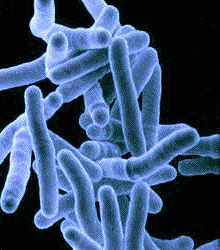
Antibiotics is used in treating tuberculin infection.
- Hydrazid
- Rifampicin
- Pyrazinamid
- Ethambutol
Tuberculosis localizes especially in the lungs but can also affect kidneys, bones or other tissues.
There are three main diagnosa methods regularly used in hospitals all over the world
i. The first made in cases of suspicion is the skin testing at Tuberculin, a purified protein derivate that checks the exposure of the patient to the infection. Although he might not have developed the disease, the patient that had contact with the bacteria causing the infection has possibly developed a type of hypersensitivity. The PPD will be injected under the skin and verified after 48-72 hours to detect a possible enlarged papule. A positive result of the testing indicates the primo infection to Tuberculosis. This test is not 100% certain and cannot guide the doctor to a sure diagnose without other investigations.
ii. The secondary investigation is the search for Mycobacterium Tuberculosis in the sputum or other organic fluids or tissues.
iii. The third but most meaningful testing is the chest X-ray detecting any kind of pulmonary injuries assembling to the ones in Tuberculosis. These three methods must be connected with significant signs and symptoms for Tuberculosis.[Tuberculosis Symptoms]
After a certain positive diagnose has been established, the doctor must proceed by other kind of tests to find the best treatment and the most adequate drugs to treat Tuberculosis.
As Tuberculosis infection can be caused by different strains of the bacteria, more recent genetic research has improved the speed of diagnose by using the polymerize chain reaction (PCR). Through the strain multiplication of a microscopic bacterial fragment doctors obtain the genetic material required to establish the right treatment.
Prevention methods are also available in TBC cases. The BCG vaccination during childhood decreases the risk of Tuberculin infection at children. A good ventilation of the air in public places disperses the bacteria and reduces the risk of contact. Ultraviolet rays are most helpful in closed environments as they also kill Mycobacterium Tuberculosis, but they cannot guarantee the 100% certainty of prevention.
The basic treatment of Tuberculosis is a combination of more antibiotics found to be efficient against the particular type of bacterial strain. One single antibiotic is likely to lead to resistance developing. The cure must last for at least 6 months but the duration of treatment can go up to 9 months or a whole year.
There are three main diagnosa methods regularly used in hospitals all over the world
i. The first made in cases of suspicion is the skin testing at Tuberculin, a purified protein derivate that checks the exposure of the patient to the infection. Although he might not have developed the disease, the patient that had contact with the bacteria causing the infection has possibly developed a type of hypersensitivity. The PPD will be injected under the skin and verified after 48-72 hours to detect a possible enlarged papule. A positive result of the testing indicates the primo infection to Tuberculosis. This test is not 100% certain and cannot guide the doctor to a sure diagnose without other investigations.
ii. The secondary investigation is the search for Mycobacterium Tuberculosis in the sputum or other organic fluids or tissues.
iii. The third but most meaningful testing is the chest X-ray detecting any kind of pulmonary injuries assembling to the ones in Tuberculosis. These three methods must be connected with significant signs and symptoms for Tuberculosis.[Tuberculosis Symptoms]
After a certain positive diagnose has been established, the doctor must proceed by other kind of tests to find the best treatment and the most adequate drugs to treat Tuberculosis.
As Tuberculosis infection can be caused by different strains of the bacteria, more recent genetic research has improved the speed of diagnose by using the polymerize chain reaction (PCR). Through the strain multiplication of a microscopic bacterial fragment doctors obtain the genetic material required to establish the right treatment.
Prevention methods are also available in TBC cases. The BCG vaccination during childhood decreases the risk of Tuberculin infection at children. A good ventilation of the air in public places disperses the bacteria and reduces the risk of contact. Ultraviolet rays are most helpful in closed environments as they also kill Mycobacterium Tuberculosis, but they cannot guarantee the 100% certainty of prevention.
The basic treatment of Tuberculosis is a combination of more antibiotics found to be efficient against the particular type of bacterial strain. One single antibiotic is likely to lead to resistance developing. The cure must last for at least 6 months but the duration of treatment can go up to 9 months or a whole year.

